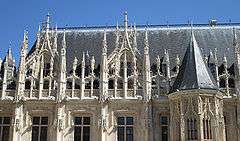Flamboyant
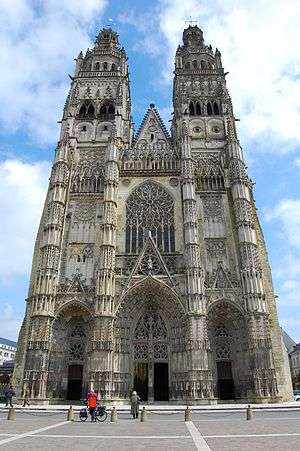

Flamboyant (from French flamboyant, "flaming") is the name given to a florid style of late Gothic architecture in vogue in France from about 1350 until it was superseded by Renaissance architecture during the early 16th century,[1] and mainly used in describing French buildings. The term is sometimes used of the early period of English Gothic architecture usually called the Decorated Style; the historian Edward Augustus Freeman proposed this in a work of 1851.[2] A version of the style spread to Spain and Portugal during the 15th century. It evolved from the Rayonnant style and the English Decorated Style and was marked by even greater attention to decoration and the use of double curved tracery. The term was first used by Eustache-Hyacinthe Langlois (1777–1837), and like all the terms mentioned in this paragraph except "Sondergotik" describes the style of window tracery, which is much the easiest way of distinguishing within the overall Gothic period, but ignores other aspects of style. In England the later part of the period is known as Perpendicular architecture. In Germany Sondergotik ("Special Gothic") is the more usual term.
The name derives from the flame-like windings of its tracery and the dramatic lengthening of gables and the tops of arches. A key feature is the ogee arch, originating in Beverley Minster, England around 1320,[3] which spread to York and Durham, although the form was never widely used in England, being superseded by the rise of the Perpendicular style around 1350.[4] A possible point of connection between the early English work and the later development in France is the church at Chaumont.[4] The Manueline in Portugal, and the Isabelline in Spain were even more extravagant continuations of the style in the late 15th and early 16th centuries.
In the past the Flamboyant style, along with its antecedent Rayonnant, has frequently been disparaged by critics. More recently some have sought to rehabilitate it. William W Clark commented:
The Flamboyant is the most neglected period of Gothic architecture because of the prejudices of past generations; but the neglect of these highly original and inventive architectural fantasies is unwarranted. The time has come to discard old conceptions and look anew at Late Gothic architecture.[5]
Examples in France
Religious buildings
- Abbeville (Somme), St. Vulfran Collegiate Church
- Auch (Gers), Auch Cathedral (except the façade)
- Beauvais (Oise), choir and chapels of the Church of Saint-Étienne de Beauvais
- Bourg-en-Bresse (Ain), Royal Monastery of Brou
- Caudebec-en-Caux (Seine-Maritime), Church of Notre-Dame
- L'Épine (Marne), Notre-Dame de l'Épine
- Évreux (Eure), north transept of Évreux Cathedral
- Louviers (Eure), Notre-Dame de Louviers (north and south façade)
- Paris, Church of Saint-Séverin
- Paris, Saint-Jacques Tower, bell tower of the former church of Saint-Jacques de la Boucherie
- Pont-de-l'Arche (Eure), Notre-Dame-des-Arts
- Rouen, Rouen Cathedral (in part)
- Rouen, Church of Saint-Maclou
- Rouen, abbey-church of Saint-Ouen
- Rue (Somme), Chapel of Saint-Esprit
- Saint-Nicolas-de-Port (Meurthe-et-Moselle), Basilica of Saint-Nicolas
- Saint-Riquier (Somme), Abbey
- Senlis (Oise), transepts of Senlis Cathedral
- Sens (Yonne), Sens Cathedral (south transept)
- Thann (Haut-Rhin), St Theobald's Church
- Toul (Meurthe-et-Moselle), west façade of Toul Cathedral
- Tours, Tours Cathedral
- Vendôme (Loir-et-Cher), west façade of the Abbaye de la Trinité
- Vincennes (Val-de-Marne), Sainte-Chapelle.
Civil buildings
- Beaune (Côte-d'Or), hospices
- Beauvais (Oise), former episcopal palace
- Bourges (Cher), palace of Jacques-Cœur
- Paris, Hôtel de Cluny
- Paris, Hôtel de Sens
- Rouen, Palais de Justice
Some examples of the Flamboyant Gothic Style outside France
- St. Lorenz, Nuremberg (nave ceiling in particular), Germany
- Milan Cathedral, a relatively rare Italian building in the style, which is adopted very fully here
- Vladislav Hall in Prague Castle (vaults), Czech Republic
- Seville Cathedral, Spain
- Batalha Monastery, Portugal
Gallery
St. Vulfran Collegiate Church, west façade, Abbeville Church of Saint-Étienne, interior, chevet, Beauvais 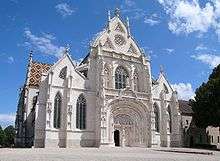

Notre-Dame de l'Épine, west façade, L'Épine Évreux Cathedral, north transept façade, Évreux 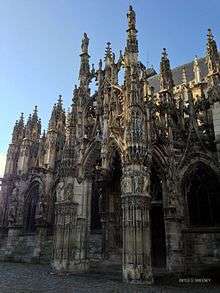
Church of Notre-Dame de Louviers, south porch, Louviers 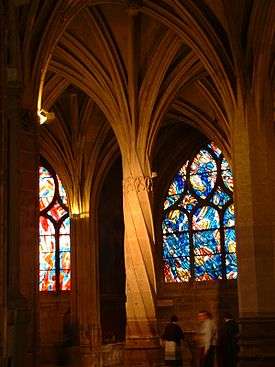
Church of Saint-Séverin, interior, twisted pier, Paris 
.jpg)
Church of Saint-Maclou, west façade, Rouen Abbey-church of St. Ouen, nave elevation, Rouen Chapel of Saint-Esprit, Rue 

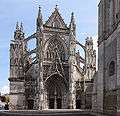
Abbaye de la Trinité, west façade, Vendôme
See also
| Look up flamboyant in Wiktionary, the free dictionary. |
References
- ↑ Benton, Janetta Rebold, Art of the Middle Ages, pp. 151-152, 2002, Thames & Hudson (World of Art), ISBN 0500203504
- ↑ Hart, Stephen, Medieval Church Window Tracery in England, pp. 1-4, 2010, Boydell & Brewer Ltd, ISBN 1843835339, 9781843835332
- ↑ "Flamboyant style". Retrieved 3 February 2010.
- 1 2 Harvey, John (1950). The Gothic World. Batsford.
- ↑ Medieval France: An Encyclopedia (Routledge, 1995 ed. Kimbler et al.), entry 'Gothic Architecture' by William W Clark.
Bibliography
- Yves Bottineau-Fuchs, Haute-Normandie Gothique: Architecture Religieuse. Paris: Picard, 2001.
- Ethan Matt Kavaler, Renaissance Gothic: Architecture and the Arts in Northern Europe, 1470-1540. New Haven: Yale University Press, 2012.
- Linda Elaine Neagley, Disciplined Exuberance: The Parish Church of Saint-Maclou and Late Gothic Architecture in Rouen. University Park, Penn: The Pennsylvania State University Press, 1998.
- Roland Sanfaçon, L'architecture Flamboyante en France. Quebec: Les Presses de l'Université Laval, 1971.
